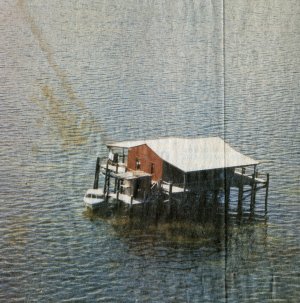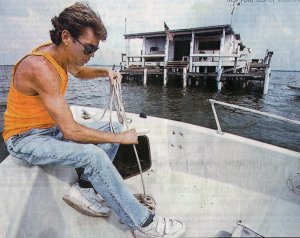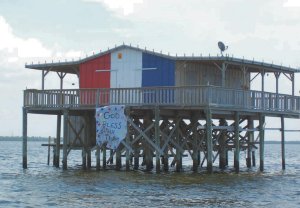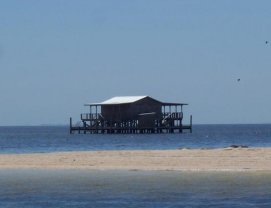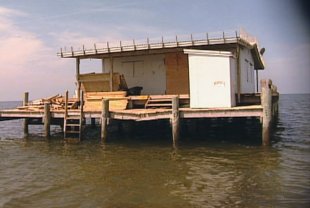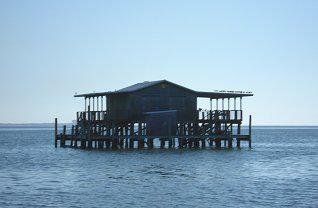Your cart is currently empty!

RAO MUSUNURU, M.D. MUSEUM & LIBRARY
HISTORY OF PASCO COUNTYStilt Houses in the Gulf of Mexico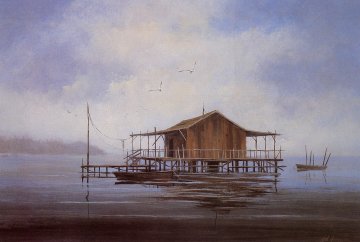 This page was last revised on Aug. 27, 2018. The early history of the stilt houses off the coast of Pasco County is unclear. In one of the following newspaper articles, William John Baillie Jr. (1880-1965) claims to have built the first one; another article credits James Washington Clark Jr. (1880-1940). According to John Grey, the first stilt houses were erected off the coast of Port Richey between 1916 and 1918 to shelter fishermen and store the mullet they caught in nets. John Richard Sawyer II (1861-1936), an early resident of what would become Elfers, had a fish camp between Green Key and what is now Gulf Harbors, according to the recollection of a son, Irvin Sawyer (1914-1993). An article in the Tampa Tribune on Sept. 26, 1974, reported that before October 1968 there were 24 stilt houses. That month, Hurricane Gladys destroyed most of them, but some were rebuilt. The article quoted Mrs. Maxine Swartsel Gause: “Those of us who lost our camps in the 1968 storm were allowed to rebuild, but our locations were pinpointed and now we rent an acre of underwater land. The state controls the resources and we pay $100 a year on a five-year contract.” Sam Allgood, who built his first stilt house in 1949, recalled that at that time building a camp on the Gulf was a matter of squatter’s rights. They went out into the Gulf, found a spot they liked, and built a home. But when most of the homes were destroyed by Gladys in 1968, the state legislature prohibited the practice of building stilt homes over the water. In 1989 he recalled that Pasco County owners put up a fight and were “grandfathered in” under the law, which allowed owners to rebuilt and hold a lease on the area beneath their homes until July 1, 1999. Johnny Cash frequently visited Des Little’s fish camp. On at least one occasion, in March 1976, Cash brought along a friend, the Rev. Billy Graham. Pete Little recalled later that to repay use of the camp, Cash bought Des Little a Toyota truck. On April 27, 1995, the St. Petersburg Times reported that the Florida House of Representatives approved a bill that would allow a dozen stilt houses in the mouth of the Pithlachascotee River damaged by the no-name storm of 1993 to be rebuilt. According to the newspaper article, the stilt homes were owned by New Port Richey Realtor John Grey; Swartsel Groves Inc. of Elfers; George “Bud” Brown and David E. Lake of Port Richey; Phillip Cunnagin, Palm Harbor; Kendall and Dale Jones of Eustis; W. M. Stevenson, Elfers; and Richard Stevenson, Michaeline Little, Don Uzzle, Sam Allgood, James W. Baillie, and Sally Gleason, all of New Port Richey. Pasco Property Appraiser Ted Williams removed the homes owned by Baillie, Grey, Little, Swartsel Groves, Jones and Richard Stevenson from the 1994 property tax roll because the homes were destroyed and cannot be rebuilt. In September 1998 the Florida Governor and Cabinet granted a reprieve from a 1976 agreement that required all stilt houses to be demolished by July 1, 1999. Under the new agreement, the houses can remain until 2019. The owners of 12 Pasco County houses and the owners of ten other houses off the coast of Charlotte and Lee counties had asked the cabinet for an extension. In 1999 the Florida Forever Act established a program to acquire environmental lands. It contained three sentences that allowed most stilt house owners to rebuild after a disaster. The 1999 law says the owners must meet two criteria. They need a lease with the state, and they must have a historic designation, or at least be eligible for it. The Department of Environmental Protection also requires them to update their sanitation systems. A Tampa Tribune article of July 9, 2005, reported that Peck Casson, who leases a stilt house in the Gulf of Mexico near the mouth of the Pithlachascotee River in Port Richey, was preparing for Hurricane Dennis. “When the weather gets really threatening, I take the [propane] gas tanks off the porch and put them inside the house,” Casson said. “I raise things on the floor to a higher level in case water gets in from a surge.” Casson said mud, water, debris and seagrass got into his stilt house during the 1993 No-Name Storm, rising about a foot above the floor level. Much of the house and docks required rebuilding. Casson noted that the nine stilt houses off the west Pasco shore are not insurable. On April 1, 2006, a speeding power boat with no one aboard crashed into Stilt House No. 5, owned by Don and Doug King. During the night of June 29, 2010, the southernmost stilt house was destroyed by fire, possibly caused by lightning. On the evening of Aug. 25, 2018, stilt house No. 6, owned by the Lake family, was destroyed by a fire that was caused by lightning. 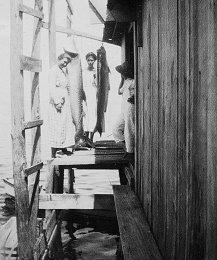 HOUSES ON STILTS, GETTING AWAY FROM IT ALL (1962)
Many a time have we heard the expression by some frustrated businessman or individual that is pressed beyond endurance by the rush and hurry, “I wish I could go to some island where I could get away from it all.” Well, through the years a number of people have made this wish come true by creating their own, not exactly island, but a refuge where they can do just that. If one goes to any point along the gulf near New Port Richey and looks out perhaps a mile or a little more, he will see a line of small, weather beaten houses built on piling about six feet above high tide. Most of them have a porch or deck around them. They are accessible by boat only and though they look tiny from a distance some of them are roomy and have most of the appointments of a modern home, with the exception of electricity. They are well braced against the storms and wind. It is amazing how they come through even the fringe blow of a hurricane, though they have not been put to the test of the full force of one of these tropical storms for this favored coast seems to be out of the paths of hurricanes. Of course each family or club has a battery radio which gives the usual storm warnings, and the wise lock up and leave before bad weather strikes. In the Summer particularly they are occupied on week ends, holidays and vacations. They are delightfully cool and offer relaxation and peace to their occupants. One can always catch a mess of pan-fish for supper from the deck, or get in their boats and cast about over the flats, bringing in trout and other larger fish. Truly, these unusual cabins on the water offer a retreat to the tired and weary as well as the fun-seeking carefree who want to let their hair down, and more or less go native. 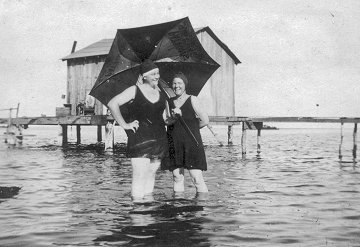 WATER CAMPS – A RETREAT FROM ‘WORK-A-DAY’ WORLD (1973)
This article appeared in the St. Petersburg Times on Sept. 30, 1973. Picture caption: Members of the Allgood family congregate for a meal in their weathered stilt house. The water ‘camp’ was built about a mile into the Gulf in 1949. By RUTH CARLEY NEW PORT RICHEY – Myriad schools of small fish congregated in the shade underneath the house; large silver-colored dolphins played near the steps and flocks of seagulls swooped and dived outside the window. Sam, 8, and his brother, K. C., 3, were the fishermen of the day. They were fishing from the porch – the same spot where their mother fished when she was a tiny tot. Boaters who head out into the Gulf here for the first time may think they are seeing a mirage about a mile offshore. Dotting the horizon, sitting high atop stilts, are 14 quaint houses with about a half-mile seascape between them. But, to long-time residents in West Pasco County, the weathered-looking houses are familiar landmarks – part of the area’s history – traditional and peculiar to this community. To the owners, their “homes on stilts” are wonderful retreats from the “work-a-day” world – from ringing telephones, bustling traffic, noisy neighbors and even from such things as pesky mosquitoes and flies. It’s a life where cool sea breezes continually blow – where time becomes meaningless and the mornings and afternoons run together into one long, lazy day. Here, one may go swimming at a minute’s notice, by merely diving off the front porch. Or, the laziest of fishermen may stretch out on a bench or flop down on a deck chair, sip his favorite drink while dangling his fishing line overboard. (Often a trap door in the bedroom may be opened to accommodate fishermen on a cold day.) Sam and K. C. (Kenneth Clay) were visiting their grandparents, Sam and Jo Allgood, recently. They are the sons of the Allgood’s daughter, Abby and her husband Kenneth Misemer, a lawyer in Sarasota. Sam Allgood is the senior partner of the New Port Richey law firm of Allgood, McPherson and Cobb. The Allgoods have lived here since 1948, and they built their unusual vacation cottage in 1949. Since that time there have been very few days that some member of the Allgood family and their friends haven’t been at their camp. The “home on water” has all the comforts of a “home on land” except drinking water. Bottled gas provides fuel for cooking, heating and lighting. The beds in one end of the large room are situated to get the cross- breeze as are the two couches at the other end. The kitchen equipped with an old fashioned water pump is in the other end, and in the center is tee “congregating place” – a long, long table which roust seat at least 20 to 25 persons. Storage space is provided by a shelf running around the wall and by a platform on the rafters. Their camp, and most of the other 13, weathered all that was thrown at them by the elements until the arrival of the October 1968 hurricane. The Allgood camp, as well as 11 of the others were leveled, but all are now rebuilt on their same locations. But, there will never be more than 14 camps because governmental permits will not be granted for additional structures in the Gulf. Owners of the camps pay an annual lease for the area where their camps are situated. Camp owners are required to install chemical toilets in the small rooms built for toilet facilities on a deck at a lower level than the porch. Who first had the idea of building a house a mile out in the Gulf? The first ones were built for an entirely different purpose. “Uncle Willie” Baillie, pioneer resident of West Pasco who died in 1965, once told this reporter that he built the first one in 1902. He and his brother, R. E. Baillie, got the idea of building a fish camp right on tee fishing grounds so they could watch for mullet runs. They netted and sold mullet for their livelihood, and were compelled to pole their boats from the shore out into the Gulf, fish all day and then pole back at night. He said he and his brother sharpened one end of the pilings, cut a cypress tree and roughed out the lumber, put it on a barge and floated it out to the site. He said building the camp was one of the best things they ever did because it served them well. They had a place to sleep, eat and rest between mullet runs and a place to clean and pack their catch. “Uncle Willie” told me they salted and packed the mullet in barrels, stomping them down with their feet so as to get at least 500 to a barrel. “Run” boats would come by and pick up the fish, take them to Cedar Key where they would be shipped north, or sometimes the Baillies sold mullet to the “Katie” a boat owned by McCrary and Dulaney’s Fish House at the mouth of the Pithlachascotee River. 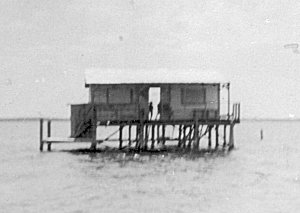 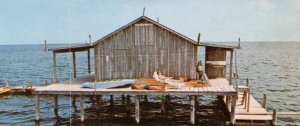 ‘SHACKS’ IN GULF OF MEXICO AREGREAT FOR “GETTING AWAY FROM IT ALL’ (1977)
This article appeared in the Suncoast Shopper & News on Aug. 17, 1977. Picture caption: Weekend retreat for about 15 families is one of the “shacks” built on stilts in the Gulf of Mexico, north of Green Key. Mike Olson, Pasco County Commission chairman, who owns the “shack” shown above, says the fishing is fine, the relaxation is great but there is always work to be done. He and a friend just finished putting a new roof on the house and the left-over rolls are on the lower deck for loading in the next boat headed for shore. By WILLIAM C. PASCO JR. Many a visitor to the Upper Suncoast has driven out toward Green Key Beach in New Port Richey, looked to the north and noticed some houses on pilings far out in the Gulf of Mexico. If the visitor later happened to ask what the remarkable buildings were. most local residents would surely answer, “Shacks.” For that’s what they’re called, shacks. Don’t let the name fool you. In spite of the name, they’re nice homes, well furnished and decorated, often beautifully paneled inside. They serve mainly “as weekend retreats for local people and, in some cases for vacationers from outside the Upper Suncoast. The first shack was built by the late James W. Clark Jr., whose father was a pioneer settler of the area. Jim Clark served three terms as New Port Richey mayor and was the town’s first fire chief. He also built the brick building at the southwest comer of Main and Boulevard in New Port Richey. Clark wanted a place where he could rest and get away from the petty annoyances of life on land. So he erected the first shack, a house on pilings not far off the mouth of the Cotee River. In time, other people followed Jim Clark’s lead. A sort of low ridge winds through the Gulf waters just offshore of Port Richey and New Port Richey; as the years went by, other shacks were constructed along this ridge. Clark built the first shack more than 50 years ago. Mike Olson, Pasco County commission chairman, built the last shack nine years ago. Olson described the problems involved in constructing a house on piles. Explaining that the water is perhaps only four feet deep at low tide along the ridge on which the shacks are built, he said the bottom and silt are blown away with special equipment so the piles can be footed in the solid limestone underneath the sandy Gulf bottom. Even though the pilings are treated, they have to be replaced periodically, he said. Once the pilings are in place, building the shack isn’t too much different from building a house on land. “Except,” Olson pointed out, “you have to take everything that is used, from nails and bolts to levels and ladders, out to the building site in a boat.” There is no electricity on the shacks so any power tools used in the construction have to be gas-powered or as one of the shack builders said, “sweat powered.” Olson’s shack is the farthest out of the some 15 or so shacks built along the limestone ridge. His nearest neighbor is a good 100 or 150 watery yards removed. Boats tie to the lower level deck of the shack from which a short flight of steps leads to the upper deck. The solitary room of the shack is completely encircled by a wooden deck. Huge sliding plywood walls can be opened on the east and west sides of the shack to provide for ventilation. Olson said one of his projects in the near future will be to stain the shack. He and a friend, Gary Joiner, have been working on the shack this summer replacing bolts, timbers where necessary and whatever other repair or rebuilding chores seemed necessary. Sea gulls are something of a problem around a shack. Not only do they white-wash a roof with their droppings, but at night they tramp about, sounding more like an army than a flock of birds. One shack owner has hung fish nets above his roof with the idea of keeping the gulls off. Another owner even set up a small cannon that fired automatically every half-hour, but the gulls soon got used to it and then ignored it. Olson’s may be the last shack to be built in the gulf of Mexico off Port Richey because in recent years, ecologists and environmentalists have opposed any type of construction in the waters. This opposition plus the tax picture on the shacks which seems to be increasing each year along with the natural disasters of hurricanes and lightning may make the shacks off the Port Richey coast a thing of the past eventually. But for the present, the shacks are in splendid condition. Around them their owners catch redfish, trout, grunts. (Olson has even caught tarpon and shark.) Other owners, perhaps not so interested in fishing, go out to their stilt-houses to relax or to entertain guests who appreciate a day’s privacy in quiet surroundings. 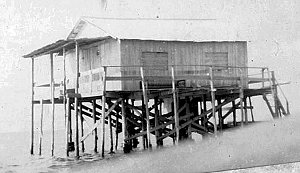 A PLACE APART FOR PEOPLE WHO LOVE THE WATER, SOLITUDE (1986)
This article appeared in the St. Petersburg Times on Oct. 12, 1986. By ANITA KILPATRICK GULF OF MEXICO – When Dale Jones, 66, feels the urge to get away from the demands of his business in the central Florida city of Leesburg, he heads for his stilt house in the Gulf. Rocking on the porch on the west side of the house and looking out over an endless expanse of water, Jones tells why he enjoys spending time here: “It’s just a relaxing place. We can forget about the telephone, and we can forget about television. We can forget about business.” What makes his hideaway so special to Jones is its location – about a mile out in the Gulf, off the coast of New Port Richey, near the mouth of the Pithlachascotee River. A simple, wooden structure sitting on tall pilings sunk into the Gulfs bottom, Jones’ cabin is one of 13 stilt houses, or fishing camps, that make up this odd neighborhood that stretches up and down the coast of Pasco County. From the shore, 10 minutes away by motorboat, the camps look like a surrealistic collection of toy houses. Like Jones, other part-time residents of the stilt houses – who may come out for an afternoon, a weekend or a couple of months or more – share a love of the water and a sense of adventure.
Those with a pioneering spirit appreciate the fact that this is a place apart. By forgoing many modern conveniences, the stilt house owners can experience camp life much the way their predecessors did. Stilt house folks must bring in their own gas and fresh water, usually in large 55-gallon drums, generate their own electricity and haul off their garbage and debris. Of course, many bring along radios, televisions, even telephones. But still, there’s plenty of time spent here just fishing off the porch, playing cards and watching the sunsets. The past according to folklore According to local folklore, Pasco County’s first stilt houses went up in the Gulf just after the turn of the century. They were built by fishermen, says Mike Olson, Pasco County’s tax collector, a former county commissioner and a former owner of a stilt house. “They didn’t have outboard motors so they used poles to push their flat boats out from the (Pithlachascotee) river. It was a place for them to stay overnight, to get out of the weather so they wouldn’t have to pole back into the river. It kind of evolved out of a necessity.” In years past, anyone who had a mind to could go out, stake a claim by putting down pilings and build a fish camp. But after Hurricane Gladys destroyed all but two of the existing camps in November 1968, the Florida Legislature put an end to that practice by prohibiting the building of new stilt houses on the state’s submerged lands.
“We’re roughing it – sort of,” Dale Jones points out as he shows a visitor around the one-room interior of his camp. There’s just enough room for the necessities – eight beds painted blue and covered with mix and match sheets, a cedar chest and storage spaces stuffed with straw hats, boat shoes and bedding supplies. On the wall a large poster shows the “Marine Fishes of the Gulf and South Atlantic.” In the kitchen corner, behind a freestanding counter are a gas stove, gas refrigerator and a sink without faucets. Overhead hang old-fashioned gaslights. To one side, next to a large open window that gives a picture-perfect view of blue skies and billowy white clouds, are shelves holding foodstuffs and stacks of pottery in bright, primary colors. Outside, a wrap-around deck leads to a chemical toilet and shower stall. The stilt house that belongs to W. D. “Des” Little is similarly designed to be simple but to have all the comforts of their home on Moon Lake Road in New Port Richey. Describing the camp as “pretty comfortable,” he points out, “We have gas cooking. I have solar energy for the lights, television …” Television? “Oh, of course,” he exclaims, throwing his hands up. “I couldn’t go out there without my soap operas.” He names Santa Barbara as a current favorite. Though he built his first camp more than 35 years ago, long before Pasco County was highly developed, Little explains that the stilt house was meant to help him “get out of this hurly burly of a city.”
Micky, meanwhile, raves about “how nice it is when everybody’s out there. They swim, fish and everybody’s having a good time. It’s like a big picnic.” Which reminds Des of a Fourth of July, some years ago, when about 70 people showed up at their camp and he went ashore to buy out the town’s supply of hot dogs. While he was cooking, he recalls, grinning a big grin, “Some people would come and say, ‘I could smell it. Here I am.’ It was standing-room only. In fact, we ran out of standing room – some of them had to swim.” On weekends, the crowds are in Crowds are a regular weekend occurrence at Jimmie and Jane Baillie’s stilt house, about a mile south of the mouth of the Cotee River. This is Labor Day weekend, and Jane, sitting in the midst of wall-to-wall people, exudes a calmness that is enviable. She obviously enjoys playing host. Jimmie, meanwhile, can be found out at the grill cooking up part of a 25-pound batch of spicy chicken wings. Although Jimmie, 60, can remember his mother saying that she “brought me out here in a clothes basket,” the Baillies are relative newcomers to the fishing camp community. They took over the stilt house that belonged to Mike Olson until three years ago. “I had some hunting property he wanted so we sort of traded,” says Jimmie, a retired commercial fisherman who has taken to living out at the stilt house as long as the weather permits – or until hunting season starts.
Duke, the Baillies’ pit bull, enjoys napping on one of four double beds when he’s not being coaxed to show off his appetite for freshly caught fish. Outside on the porch are a picnic table, a pair of shark’s jaws nailed to the wall and a portable radio blaring rock ‘n’ roll. On the wall, in plain view, is a hand-scrawled message: “Overnite Guests By Invitation Only.” Jane laughs and says, “Well, we had Greek Easter out here this year – and none of us is Greek so don’t ask me explain – but we had 35 sleep over.” Despite the hordes of visitors, Jane Baillie says she gets to enjoy some quiet moments here after putting in a full work week at her beauty salon. “Every night out here the sunsets are beautiful,” she says. Even summer storms don’t bother her. “I’m not afraid of lightning so it’s beautiful.” Sighing with satisfaction, Jane remarks, “I don’t remember what we did before we came out here on weekends.” The challenges of construction If living in a stilt home in the Gulf is roughing it, then building a stilt house is real physical punishment. When asked what it takes to build a stilt house, Des Little rocks back in his chair and exclaims, “Guts and strength. Guts and strength.” “We didn’t build ours,” he says, “until I decided I was tired of going out there and spending the night with somebody else.” He tells how he cut down 22-foot palm trees, trucked them to the river, tied them to a boat and floated them out to the site: “I wish I could draw you a picture or show you a picture of how we did it… I went out there and took a rod and where the rock wasn’t too hard, I put my pilings down. The first one’s real hard. We’d go out Saturday afternoon and work like hell until dark. Dig a hole with a jet pump. put a board in the hole and walk the piling up.” For his camp, Little and his crew put in 32 pilings in two weekends. “That’s one of the hardest jobs you’ll ever run into in your life,” Little contends. “People go out there today, and they don’t appreciate the hard work.” After the pilings, which are sunk at least five to six feet into the floor of the Gulf, come the floor and decks. “You ever try to take an estimate while you’re standing in a boat, bobbing up and down?” Little asks, chuckling at the memory of building the floor. “We got ours pretty level, didn’t we, Micky?” he says, turning to his wife. “Pretty good.” she says, shrugging. “Well, none of us ever rolled off the bed at night,” Little says, laughing. Mike Olson remembers how he built his camp in 1968, when he was 24 years old: “Somehow or another, you go out there with friends, sink a few pilings, string up some lumber, and you have a dock. Sinking that first piling is a tough one. “I used it every single weekend. My routine was to get out there on Friday afternoon and stay till Sunday night. I’d load the family and the beagle up and head out there.” What makes the camps worth the trouble and worry? “If you go stay out there one night, then you’ll understand,” Olson says. “It really gets into your blood.” Since giving up his camp, Olson says, “I won’t go out there anymore – even though the people who own it are close friends. It just hurts too much.” A place of special memories Lawyer Sam Allgood of New Port Richey, another of the longtime fishing camp owners, had his built in the spring of 1949. “I just thought it’d be a great idea to have one out there,” he says. Allgood says his four daughters grew up to enjoy fishing at the camp and still use it as a quiet refuge, even in the off-season when the chill wind keeps others away. Now, a third generation is taking full advantage of the camp’s location. K. C. Misemer, Allgood’s 16-year-old grandson, says he can be found most weekends at the camp, water skiing, fishing or doing the general maintenance required. Grinning, K. C. acknowledges that having access to the weekend place hasn’t hurt his popularity at school any. One of Allgood’s favorite memories of the camp is a special homecoming after the birth of his youngest daughter: “When my baby was born, in 1950, my wife didn’t even go home from the hospital. I took her and the baby to the camp.” Then, almost 20 years later, as his baby was reaching voting age, Allgood found himself in the fight to save the camps after Hurricane Gladys blew through. Dale Jones remembers the destruction of Hurricane Gladys: “It was spawning little tornadoes, and I tell you it really blew them (the fish camps) down. We came back to build, and we found out they had passed a law that we couldn’t rebuild them. The Marine Patrol came out and stopped us.” Back then, Mike Olson remembers, the stilt houses belonged to “all the important and influential people in town,” and some of them went to Tallahassee to fight for their rights and their property. “We had to go to Tallahassee and tell them what the facts were,” says Allgood. The result of their efforts was a ruling that allows the fish camp owners to use their camps until their leases run out on July 1, 1999. “At that point, the state decided to come in and get leases drawn up for everyone,” says Olson. “It was a convenient point in history – after that hurricane – for the state to get a handle on them (the fish camps).” When the leases expire, all existing structures to be dismantled and removed. In the meantime, if any of the camps suffers more than 50 percent damage, it may not be rebuilt. “If Hurricane Elena (Labor Day weekend 1985) had gotten a little bit closer to Pasco County, we might be down to zero,” says Olson. “Every single year, at hurricane season, the people who have those Throughout the year, most owners make home improvements, keeping the no-rebuild stipulation in mind. Regular maintenance is all-important. Little’s palm tree pilings were first replaced with telephone poles and just four years ago were replaced with 10-inch plastic pipe filled with concrete. “Of course, we all tried to build better,” says Jones, “But if another (hurricane) hits, it’s gonna take it no matter what we do. If it happens, it happens. We’ll just have to accept it.” When the leases expire and “if they (the houses) are still there, if they withstand all the hurricanes,” Olson says, one of two things may happen: “Either everybody packs up and leaves, or the government draws up new leases. It probably all depends on politics.” “I’ll tell you, they’re (current owners) gonna have to fight it just like we did,” predicts Des Little. “I’d fight to save that camp. Our days are gone by out there, and we still love it, but we’re thinking of our children.” 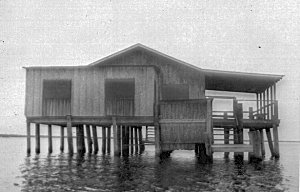 STILT HOUSES ON LAST LEGS (1987)
This article appeared in the Tampa Tribune on July 16, 1987. Picture caption: One of 12 stilt houses sits off the mouth of the Pithlachascotee River. By CHARLES T. BOWEN NEW PORT RICHEY – The summer heat means lots of activity at the stilt houses at the mouth of the Pithlachascotee River in the Gulf of Mexico. The 12 privately owned houses, located about a mile offshore, have been a fixture on the Golf coast for more than three decades. “I built my first one in 1949, but then a hurricane and tornado wiped us all out in 1968. We rebuilt in the spring of 1970,” said New Port Richey attorney Sam Y. Allgood Jr. The houses Were rebuilt under a lease agreement with the state of Florida, which owns the property. The leases expire in the late 1990s. “The leases are not renewable. After that, they’ve got to come down,” said Ken Rouse, assistant director of the Division of State Lands. Construction of stilt houses in the Gulf or any state waters is no longer allowed. Under state rules, if the existing houses suffer damages totaling at least half of their value, they can not be rebuilt. The homes have assessed values ranging from $13,382 to $17,741, according to Pasco County Property Appraiser’s Office records. “If something happens this time, that’s it. We can’t rebuild,” said Allgood. The houses have attracted more than just local residents. Johnny Cash and his wife, June Carter Cash, and the Rev. Billy Graham and his wife, Ruth, are occasional visitors to the stilt house owned by Des and Mickey Little of New Port Richey. A Little family member said June Carter Cash visited earlier this month. According to county records the houses are owned by Allgood; Little; Frank E. Brower of Treasure Island; Swartsel Groves Inc. of Elfers; W. M. Stevenson of Rowan Road; Wray Enterprises Inc. of 1709 Wray Way, Holiday; David E. Lake and George M. Brown of Port Richey; James and Jane Baillie and Robert and Tammy Pumphrey of New Port Richey; William F. Grey of New Port Richey; Copeland A. Hills of Windermere; Richard D. Stevenson Jr. of Trouble Creek Road, and Kendall and N. Dale Jones of Leesburg. 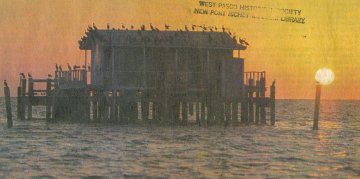 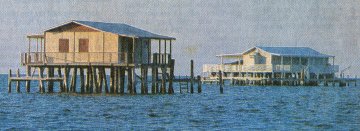 STILT CABINS’ EXISTENCE THREATENED (1993)This article appeared in the Tampa Tribune on Mar. 17, 1993. By DANIEL BERGER NEW PORT RICHEY – The cluster of stilt cabins built a mile out on the Gulf of Mexico represent a piece of a slower Florida. Built as simple fishing camps with few amenities, the rustic dwellings near the mouth of the Pithlachascotee River fostered many a golden memory for the families who own them. There are 13 of them, says art studio owner Debbie Allgood, whose father, New Port Richey attorney Sam Allgood, owns one. The weekend storm wasn’t the first the houses weathered. One of their earliest purposes, says her sister Abby Misemer, was to provide shelter for passing fishermen. But the storm may spell the beginning of the end for the houses. Several were demolished. Others were damaged. State laws not only prevent any more from being built but restrict owners from repairing them if they are more than 50 percent damaged. Their state leases, not renewable, expire in 1999. “It’s the end of a way of life,” says Jane Baillie, whose stilt house vanished during the storm. It was one her family bought from Pasco County Tax Collector Mike Olson about 10 years ago, she says. “We spent every weekend in the summer out there. The only way to get there was by boat. . . . The sunsets were gorgeous. I’m going to miss it,” Baillie says. Not all the owners are giving up. Some of the houses withstood the storm. And it isn’t clear who won’t be allowed to rebuild, Misemer says. “It’s hard to assess what’s 50 percent. I don’t know who makes the decision.” “We looked at them Sunday. There are more than we expected still standing, and they looked to be in better shape than we thought,” says Sandra Uzzle, whose family owns one. “It was a nice surprise.” After a hurricane smashed the homes in 1968, the state was slow to grant permission to rebuild, Sam Allgood says. They wanted to outlaw the houses. State officials had heard about problems with stilt houses built near Key Biscayne, Misemer says. Far more luxuriant, those became the site of wild parties and, officials charged, drug smuggling. The owners finally got permission to rebuild, but with rebuilding restrictions and 30-year leases attached, says her father, one of those who went to Tallahassee for hearings on the issue. “People who don’t have camps of their own, don’t want us to have ours,” Sam Allgood says. Their cabin – one large room with beds around the edge, a dining table in the middle and a sitting area and small kitchen – represents an important part of her family’s life, Misemer says. Birthdays and holidays were often celebrated there. In the old days, the houses were left open and stocked with food for passing boaters, and the family often got calls from people who said they meant to pay back a few cans of food, Misemer says. The cabin cost hardly anything to build in 1949, Sam Allgood remembers. They used palm pilings they cut themselves from nearby swamps, he says. At that time they had only one neighbor. The cabins had come with various owners and gone with various storms since the late 19th century. Now, Allgood says, he heard one sold recently for $60,000, although most remain simple structures. Misemer says her family has already begun repairing theirs, which survived the storm but lost some docks and pilings. “We will definitely be hammering and sawing away.” 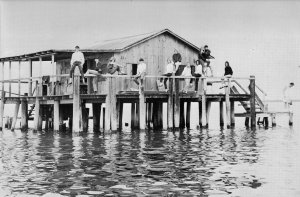 OASES IN GULF GET REPRIEVE FROM STATE (1998)
This article appeared in the St. Petersburg Times on Sept. 11, 1998. Picture caption: Richard Uzzle, 48, coils a rope as his brother’s boat nears their stilt house, which is just over a mile offshore near Port Richey. By BETH GLENN Richard Uzzle pulls a trap from the Gulf of Mexico and steps back onto his porch with a catch of a dozen blue and stone crabs. He crosses the carpet scraps covering the deck, careful to step over the rope anchoring his brother’s boat and avoid a rotten plank marked by a dartboard. “We’ve been waiting on the lease to really start doing major repairs,” he said. “But we’ll probably just fix these two boards here. Everybody loves it the way it is.” Families like the Uzzles, who since the turn of the century have enjoyed fish camps or stilt houses in the gulf, had their leases extended by 20 years this week. Under a 1976 agreement between the state and the owners, all the houses were supposed to be demolished by July 1999. But when owners of stilt houses from Pasco, Charlotte and Lee counties asked for an extension, the governor and Cabinet granted them a reprieve. “This is where my parents and I learned to fish and ski, where my kids learned to ski, and I hope my grandkids will be able to swim and ski here,” Greg Uzzle said of the fish camp christened “The Last One,” since it lies farther north in the mouth of the Pithlachascotee River than any of its neighbors. Each brother divides his time between his house on the mainland and the fish camp, which has been in their family 40 years. The brothers have a sharing arrangement that lets each use the stilt house every third week. Another of the elevated shacks stretched parallel to the coast like a string of beads has belonged to their uncle for more than 50 years. “They’re like little paradises, these places,” Richard Uzzle said. “To us they’re priceless.” Descendants of one of Pasco’s pioneer families, the Uzzle brothers trace the fish camp tradition back to the late 1800s. Fishermen originally built the camps within poling distance from the shore so that, in the days before outboard motors, they could relax there after a day’s work. They also used the camps to dry and repair nets and salt their catch for shipment. As early as the turn of the century, the Uzzles’ grandfather owned one of the camps for recreational purposes. Before the no name storm of 1993 there were 13 camps, of which the Uzzles owned three. Now they own two of the six remaining houses. With the advent of outboard motors and environmental protection, the camps were rebuilt farther offshore, and commercial fishing was banned. At the brothers’ camp, that ban extends to all work – except what’s necessary to maintain the place. “There’s no commercial business out here at all,” Greg Uzzle said. “It’s strictly pleasure; we come out here to get away from all that.” The brothers said they have stayed in their cabin for as long as two weeks before making an obligatory trip to the mainland for ice. A trapdoor in the center of the camp allows for fishing even in bad weather and also circulates a cooling breeze through the camp. They have stocked the house with a gas grill for cooking. Some mattresses covered with sleeping bags, a couch, table and papa san chair constitute most of the other Spartan furnishings. A generator fuels electric lights, a heater for winter nights and a radio that keeps camp dwellers connected to the outside world. The brothers said watching lightning storms from the camp is exquisite, and they can see fireworks from four towns from their perch 2 miles offshore. “On a clear day you can see as far as Tarpon Springs, and Anclote Key looks like you can almost touch it,” Greg Uzzle said. Though the gulf provides much, fresh water is one of the greatest challenges. They haul out ice and drinking water from the mainland, collect rainwater for showers and pump saltwater through an old fashioned pump to wash dishes. The Uzzles still remember boyhood visits to the house when they could eat clams from the gulf that were cooked in the sun on a sheet of tin. That was before the pollution set in. Though Greg and Richard Uzzle are Port Richey real estate agents who own some of the most exclusive property in or around Pasco county, Greg said the thought of being tied to a piece of dry land scares him. How to resolve the contradiction? “I try to sell houses on the water,” he said. “And I come out here as often as I can.” Richard agreed. “This is all I need,” he said. “I can’t remember any bad times out here. “I mean, is this paradise or what?” 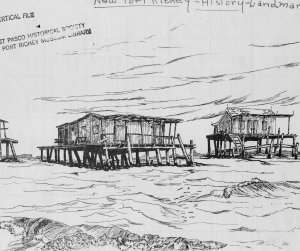 HOUSES BUILT FOR FISHING –ANGLERS POLED BOATS UP AND DOWN GULF (2005) This article appeared in the Tampa Tribune on July 24, 2005. By STEVE KORNACKI The first stilt houses were erected off the coast of Port Richey between 1916 and 1918 to shelter fishermen and store the mullet they caught in nets, John Grey said. “In the 1920s, both of my grandfathers, Grey and Boyd, built a camp about 300 feet from shore at the mouth of the river,” John Grey said. The stilt houses, built in the Gulf of Mexico near the mouth of the Pithlachascotee River, are called camps by locals who refer to their fishing camp origins. “The mullet fishermen had to pole their boats out into the Gulf back then,” said Peck Casson, who leases one of nine stilt houses still in working order. “They had no outboard motors and had to pole up and down the coast to fish. “When tides shifted and there was bad weather, they needed a place to stay and so they built the stilts.” Grey said Casson’s current stilt house, located near Durney Key and the second-most southern location of the nine stilts, is built on the site of the original Gulf stilt house. “And they’ve been rebuilt constantly ever since the first ones went up,” said Grey, 60, who owns and operates Coldwell Banker F.I. Grey & Son with his younger brother, Chuck. The move from fishing camp designs to family dwellings took off after World War II. The Allgood, Baillie, Bennett, Grey, Haines, Helms, Jones, Little, Sawyer, Stevenson, Swartsel, Thiel and Warburton families were among those building about that time. Every family built its own, said Port Richey Vice Mayor Bill Bennett, and he remembers helping his father build theirs with cypress beams and pressure-treated poles. Hurricane Gladys in October 1968 took down or severely damaged every stilt house. “There were 18 up in 1968,” said Casson, who spent much time at the Grey and Little houses with the families of his friends. “Thirteen of them were rebuilt, and the Thiel house was later taken down by lightning.” The No Name Storm of March 1993 claimed about half of the remaining dozen homes, and Casson said three families chose not to rebuild after that. Bennett said the original houses were claimed as homesteads but that changed after Gladys, when the state began leasing the sites. Casson said the original five-year leases were extended to 30 years after the rebuilding from Gladys, and about 15 years remain on the current 20- year leases. “The Legislature passed a law saying that if they are kept in good order, the leases will continue to be extended,” Casson said. The leases are “a little less than one thousand dollars per year,” and payment of county taxes also is required. Many of the children and grandchildren of the original camp builders hold the lease or have an interest in the nine remaining houses. “I can still remember my mother saying, “Take the skiff with Peck and get us some mullet or flounder for dinner,’ ” John Grey said. “The camp was and still is a unique and wonderful thing. And I’m glad they are still out there because they are a wonderful part of our heritage and history.” 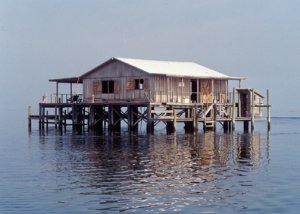 NINE REMAINING “CAMPS’ IN THE GULFARE SYMBOLS OF A RICH HISTORY (2005) This article appeared in the Tampa Tribune on July 24, 2005. By STEVE KORNACKI Nine wooden stilt houses dot the Gulf of Mexico just offshore near the mouth of the Pithlachascotee River. Their rich history dates back about 90 years, and their rebuilding after storms makes them symbols of perseverance. They have been havens to fishermen, summer homes, fishing camps, weekend getaways and constant pelican perches. But more than anything, they are a state of mind: a place Huck Finn and Jimmy Buffett would appreciate. And Billy Graham, too. The renowned evangelist and country singer Johnny Cash, who once owned a home with his wife along the river channel leading to the stilt houses, used to relax at Des Little’s “camp,” as the locals call them. “It’s really a way of life out here,” said Peck Casson, who stayed at the Little and Grey family camps as a boy and now leases one himself. “And it’s really peaceful, except for weekends.” Boaters coming too close and those casting fishing nets at the crack of dawn can disturb paradise now and then. But usually it’s just the sound of waves smacking the wood and concrete support pilings and of fish jumping out of the water. The smells are those of salty breezes and someone frying snook the next camp over. The sights are of the horizon from a wooden porch, sea trout and snook schooling in the shallows, crystal-clear saltwater, dolphins surfacing and boaters returning from play at Anclote Key. Open the windows and doors to the 24-foot-by 30-foot, one-room structures and sea breezes supply the air conditioning. Eddie Caraway and his wife, Patricia, recently spent two nights at the Lake camp, which is just north of Casson’s place and near tiny Durney Key. “Look at where you are at,” said Eddie Caraway, his feet propped up on a porch chair and sunglasses reflecting the blue sky. “It just doesn’t get any better than this. It’s like being in a big aquarium.” Port Richey Vice Mayor Bill Bennett nodded in agreement and smiled as he paced the porch next to Caraway. “Good times,” Bennett said. “That’s what these camps are. And they were our home away from home when I was growing up in one during summers.” Bennett brought out City Manager Jerry Calhoun for his first tour of the camps and the Caraways invited the vice mayor to dock his boat. “There’s such a nice breeze out here today,” Patricia Caraway said. “And we’re going to grill steak and the redfish we caught tonight,” her husband said. “You can’t have a bad time out here.” Bennett added, “It’s like heaven.” Home For The Summer Like Casson and lifelong buddies Chuck and John Grey, Bennett remembers moving out to the camps with several other families each year at the end of May and staying until Labor Day. They took boats to school, but mostly dropped a line into schools of fish. “We didn’t have air conditioning in houses back then,” said Bennett, recalling the 1950s and ’60s. “But it was cool out here.” And the livin’ was easy. John Grey recalled mullet fishermen leaving a note saying they had to use the house as refuge from a squall and they brewed some coffee. “That night, the fishermen came by our place and asked, “How many mullet y’all want?’ ” Grey said. “They left us six or seven for dinner.” Those idyllic days are long gone. Casson said his stilt house has been looted three times, and it’s now protected by an alarm system and chains bolted with a Master Lock. He pointed to saw marks on half-inch-thick links and shook his head. “And neither these houses nor the contents are insurable,” Casson said. He credited Pasco Sheriff Bob White and Cpl. Don Deso of the sheriff’s Marine Patrol Unit for helping him devise an address system for the stilt houses for patrolling purposes and quicker emergency response. “They are on something we call Gulf of Mexico Boulevard,” Deso said, “and numbered 1 through 9 in order from the north to south.” It’s a boulevard for dreamers. Lazy Days, Family Time The stilt houses are a place to live life on island time. A place where the knotted traffic on U.S. 19 and the city noises are left behind, and peace is found. Casson knows of only two other stilt house communities: one in Biscayne Bay near Miami and another off the coast of Lee County near Boca Grande. “The best thing of all about the camps is that they are a way of life,” Grey said. “Back then, it made families do things as a family. There were no distractions.” Just fishing, swimming, boating, water skiing, scalloping, crabbing and a chance to prop up your feet on the porch railing and read a good book. “We didn’t know how lucky we were out there,” Grey said. “We had time to do things like look up at the clouds and talk about what their shapes looked like.” Grey and Casson said no families spend the whole summer at camp anymore. But it remains a place to bring family and friends on weekends. The Lake and Casson family camps are festive getaways. They have many of the conveniences of home, like gas stoves and lights and satellite televisions powered by generators. And some inconveniences, like outhouses on the docks and melting ice stored in coolers to keep food fresh. They have two or three beds and extra mattresses stored in the rafters. Kitchen cabinets and counters provide a touch of home, and storage shelves and fishing poles line the walls. The Lake camp has special touches like the old Moon Lake Lodge welcome sign hanging from rafters at the peak, a wet bar with a coconut bikini and hula skirt decoration, and a surfboard. A sign reads: “The voice of the sea speaks to the soul.” Indeed. And souls find what they want out here. “We watch sunsets from the bench or a rocking chair,” Bennett said. “And many mornings a boat wakes you up slapping the water.” Casson remembered his friend, Doug King, feeding lettuce to a manatee off the dock. “Johnny Cash would go out there for a week every year just to get away from things,” Grey said. “People left him alone, and that’s what he liked about being here. “These camps bring back thousands of memories. It was just a way of life, the way it was. And you can’t go back to it.” But folks still visit.
 |
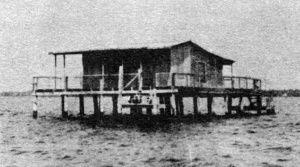 This article is taken from Tales of West Pasco by Ralph Bellwood.
This article is taken from Tales of West Pasco by Ralph Bellwood.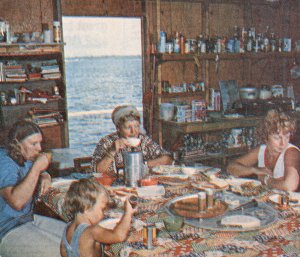
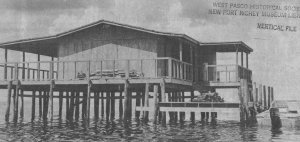
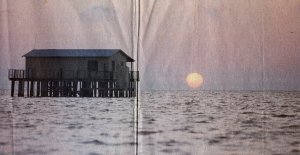
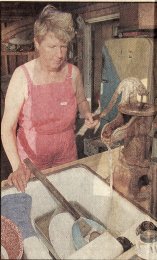 Although the water isn’t too deep – about 10 feet at high tide and
shallow enough so that you can walk across the sand at low tide – the
sight and sound of the Gulf here is almost overwhelming. It fills every
view, and when the quiet isn’t broken by the hum of a passing motorboat
or an airplane, you can hear the water splashing against the houses’
pilings. The uninterrupted view of water and sky evokes a strong
feeling of isolation and solitude.
Although the water isn’t too deep – about 10 feet at high tide and
shallow enough so that you can walk across the sand at low tide – the
sight and sound of the Gulf here is almost overwhelming. It fills every
view, and when the quiet isn’t broken by the hum of a passing motorboat
or an airplane, you can hear the water splashing against the houses’
pilings. The uninterrupted view of water and sky evokes a strong
feeling of isolation and solitude.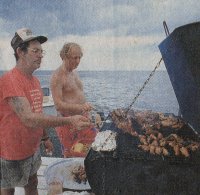 At the same time, those who had lost their camps to the hurricane
were allowed, under a “grandfather” clause, to rebuild and hold a lease
on the land underneath until July 1, 1999. With 13 years left on their
leases, camp owners acknowledge that the history of the camps may be
coming to a close. But, for now, at least, they aren’t letting anything
spoil their fun.
At the same time, those who had lost their camps to the hurricane
were allowed, under a “grandfather” clause, to rebuild and hold a lease
on the land underneath until July 1, 1999. With 13 years left on their
leases, camp owners acknowledge that the history of the camps may be
coming to a close. But, for now, at least, they aren’t letting anything
spoil their fun.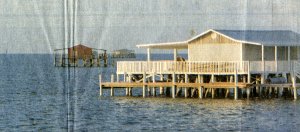 The retired paving contractor and his wife Michealine (“Micky”) stay
at their stilt house whenever they can now. “We used to just move out
there and stay,” says Des. “Last year, we stayed out there a week. We
came in for groceries and to go to church.”
The retired paving contractor and his wife Michealine (“Micky”) stay
at their stilt house whenever they can now. “We used to just move out
there and stay,” says Des. “Last year, we stayed out there a week. We
came in for groceries and to go to church.”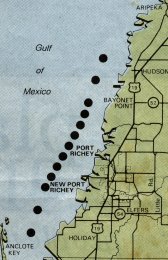 Among the eye-catching features that seem a bit out of place inside
the Baillie camp are carpeting, built-in kitchen cabinets and an old-
fashioned pump to bring salt water up from below to wash dishes. A pile
of fishing rods leans against the kitchen counter.
Among the eye-catching features that seem a bit out of place inside
the Baillie camp are carpeting, built-in kitchen cabinets and an old-
fashioned pump to bring salt water up from below to wash dishes. A pile
of fishing rods leans against the kitchen counter.